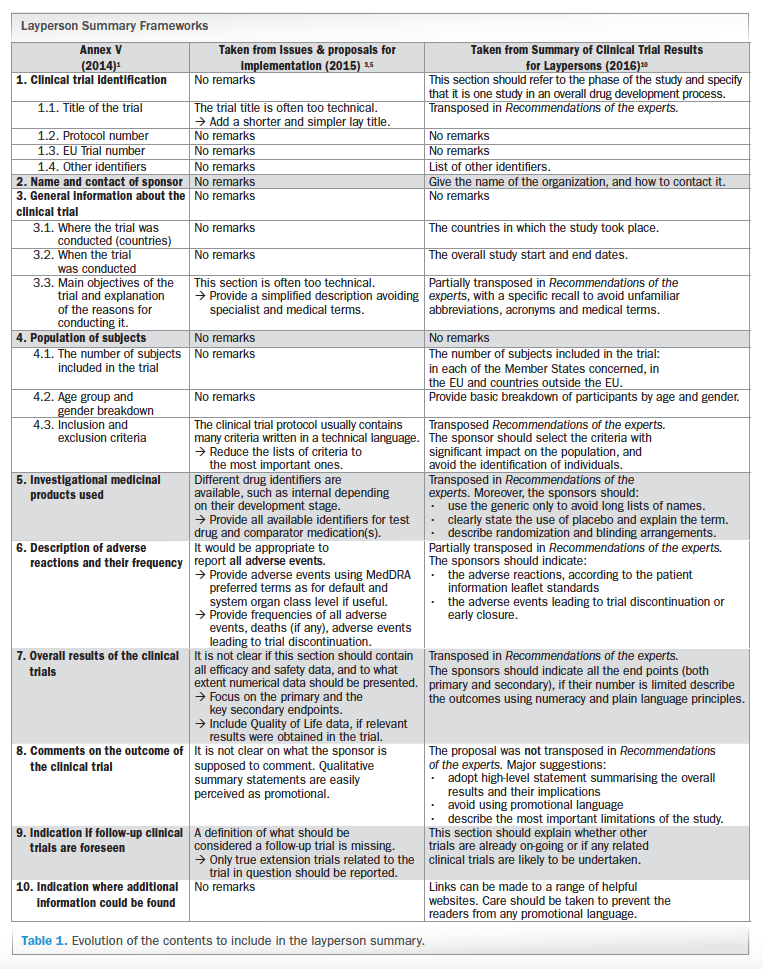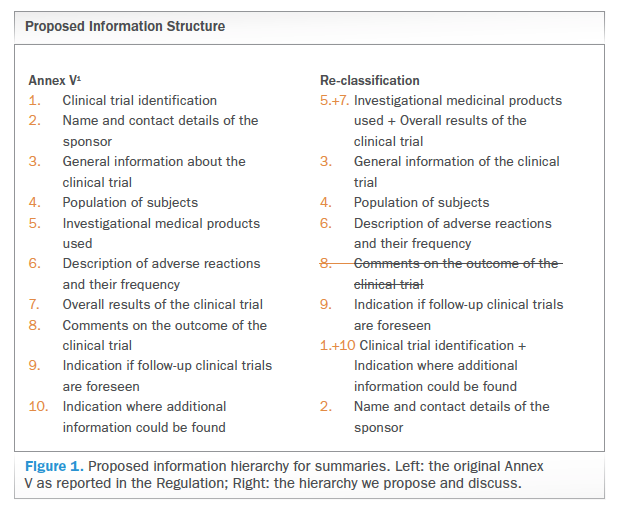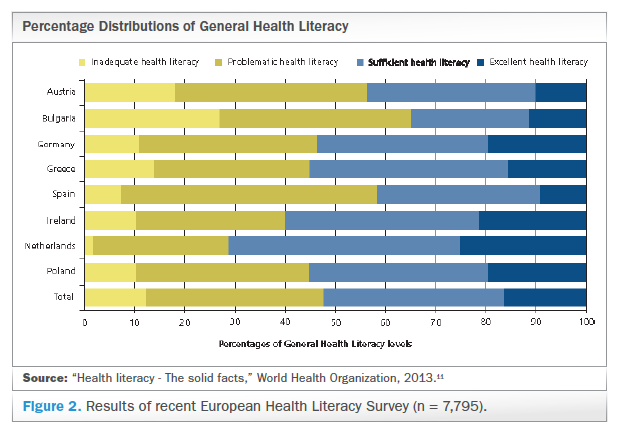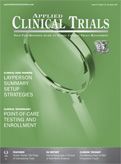Considerations on Layperson Trial Summaries in the EU
Applied Clinical Trials
Analyzing the debate around writing and constructing layperson summaries of clinical trial results-and proposing a “reader-centered” approach.

In 2014, the European Parliament released the Regulation 536/2014 on clinical trials on medicinal products for human use.1 In October 2014, the EMA policy 00702 reinforced the concept of clinical trial transparency. Both the Regulation and the Policy took regulatory decision-making one step closer to European Union (EU) citizens, and promoted better-informed use of medicines.
As a first step to promote clinical trial data disclosure, the European Medicines Agency (EMA) implemented a public European database in which to collect and retrieve all relevant information on clinical trials submitted to the agency (as per Article 81), establishing a right balance between disclosure of information and protection of anonymity and commercially confidential information. Therefore, the Regulation enables the public, patients, and healthcare professionals to identify clinical trials in an easier way and to evaluate their relevance toward an individual patient’s condition.
The second step was the requirement of a layperson summary that should complement the summary of clinical trials results. The layperson summary is a novel document specifically designed for non-medically expert patients. Both clinical trials results and layperson summary should be submitted to the European Union (EU) database within one year from the end of a clinical trials in all member states (MS) (Article 37).3 The regulation will apply six months after the European Commission will publish the notice in the Official Journal of the European Union that the EU portal and EU database are fully functional.4 This communication was originally expected on May 28, 2016 (Article 99), but, while writing this paper (January 2017), no indication from EMA was released.3
In its Annex V, the Regulation 536/2014 provides a list of items that should be included in the layperson summary. However, the Annex V does not provide any hierarchy of information (the order that each item should have in the document) and cannot be considered as guidance for writing a layperson summary.4,5 Since 2015, the debate on the items listed in Annex V and how they should be disclosed to average-literacy people has highlighted their potentially critical aspects.3,6 In 2016, a consultation document on layperson summary, released by the Medical Research Council Technology Return of Results Toolkit, specified the structure of each item and sub-item (see Table 1 below). The Regulation (Article 39) states that the trial sponsor should guarantee the clarity of layperson summaries and their proper submission to EU database; penalties for breach of transparency provisions will be proposed.6

Layperson text: Motivation and characteristics of readers
The target audience for a layperson summary is expected to include not only the general public and the participants in the clinical trials and their relatives, but also healthcare professionals, pharmaceutical researchers, and academics who may be interested in the study but are not genuine experts on the elements involved. Therefore, a balance should be reached to accomplish the average literacy level of the general population and, at the same time, provide useful information for more health-literate people.7
To correctly define the target audience, two important notions should be taken into account: the expected reader’s characteristics (age, education, culture, scientific, and trial knowledge)7 and the reason why he/she is willing to read that specific layperson summary.
The characteristics mentioned:
- Allow discriminating what should be explained and what could be tacit (level of implicit) in the layperson summary.
- Profoundly change from one reader to another.
We can reasonably suppose that the most frequent motivation for a layperson to read a clinical trials summary may be related to his/her personal health status or the health of one of their loved ones.
The readers’ age, education, and culture contribute to defining his/her ability to understand a written document, but in the particular case of a layperson summary concerning a clinical trial, it is quite likely that the health motivation driving the reader is much more relevant than his/her biographic and cultural traits. All together, these aspects represent the cognitive profile of the reader.
Therefore, while projecting the hierarchy of a layperson summary, it may be useful to keep into account the motivation and the cognitive profile of the expected reader.
First, it should be defined which information is at the top of the reader’s interest: most likely, “Is this drug effective in treating the (my) condition? Is it safe?” The answers to these questions are the discriminant information8,9 for the reader; they define the rationale for the specific content of the text, justifying the drafting of the summary and motivation for reading.
Therefore, in our opinion, the investigational medicinal products used in clinical trials and the overall results should have the maximum evidence and should be discussed as the first topic. Then, general information on study procedures, patient populations, and adverse effects should be described in detail to locate the results in their proper context. More technical information required to guarantee the transparency may be summarized at the end in a few sentences (see Figure 1 below). The proposed hierarchy agrees on the regulatory requirements, as described in Annex V, with readers’ interest and expectations.

Once the hierarchy of information is finalized to address to the readers’ primary interests, the body of the summary may be designed according to some general principles of any health-related text.
In our proposed hierarchy (right column of Figure 1), we have deleted point 8 (“Comments on the outcome of the clinical trial”). The reason for this deletion is that, in our opinion, it is useless to perform comments related to a drug’s development based on a single clinical trial. We agree with some authors’ opinions 3,5 that adding any comment to the overall result of the study is, ultimately, useless or even disturbing for the layperson reader. Annex V does not clarify what the sponsor is supposed to comment; besides, any possible qualitative summary statement seriously runs the risk of being perceived as promotional.
On the contrary, we believe that some comments on the particular result of the single trial, written with clarification purposes, could be included in the overall results, so as to keep the document as readable as possible.
The Summary of Clinical Trial Results8 recommends to:
- Adopt a low level of implicit in the summaries.
- Develop the layout and content in line with the needs of the public.
- Keep the summary as short as possible.
- Focus on unambiguous information.
- Eliminate any promotional content.
- Follow health literacy and numeracy principles.
In the development and review of the summary, specific attention should be dedicated to patients, patient representatives, and advocates. Indeed, both patients’ expectation and health literacy are crucial in checking the efficacy of the summary.4,7,9
After designing the reader-centered summary, it is essential to adopt an appropriate writing style and language that aligns with the cognitive profile of the readers. Therefore, even if readers’ characteristics regarding age, education, and culture may not affect the interest on the topic and the willingness to read and understand the summary, they may interfere with the complete understanding of the text. This aspect should be kept top of mind; according to the Regulation 536/2014, the layperson summary must be understandable, and the sponsor must guarantee its clarity.
Many studies have described both general and health-specific literacy of readers. The health literacy includes both the ability to access, understand, and elaborate on information to promote and maintain good health and the cognitive and social skills that motivate an individual to approach health content.10 A recent European Health Literacy Survey11 shows that almost half (29% to 62%) of the population involved in the analysis had inadequate or problematic health literacy, with great differences among countries (see Figure 2).

Based on Figure 2, it may be important to remove or limit at the minimum any medical jargon and explain any medical objective or outcome in easy, daily words.
Concerning the general literacy, two adult literacy surveys (the Adult Literacy and Lifeskills Survey [ALL]12, and the International Adult Literacy Survey [IALS])13 are currently available, and a third (the OECD’s Program for the International Assessment of Adult Competencies [PIAAC]) is in progress.14 The Summary of Clinical Trial Results refers to the IALS that identifies five levels of proficiency ranging from level 1 (lowest) to 5 (highest) and points out that communications written for the general public should use simple everyday language to ensure ease of reading and understanding.10 Text should be suitable for people with a low to average level of literacy. Across Europe, the average proficiency level is 2-3, whereas level 3 corresponds roughly to high school completion.10 Sponsors should consider testing the readability of an initial version of the study results summary with a small number of people, representative of the target audience (e.g., patients with a particular disease, patient association representatives, key influencers of public opinion).
The readability of texts can be formally determined using different metric tools currently available in many European languages (see Table 2 below). For a layperson summary written in English, the Flesch Reading Ease Score should be used: the higher the test score, the easier the text is to read; anything scoring 70 and above is considered easy to read.10

The Flesch Reading Ease Test17 can be useful in multi-country studies where summaries are first drafted in English and then translated into other languages.10 Sponsors are encouraged to consider including an English version if the trial did not include the UK.10 However, the Regulation 536 states that the layperson summary should be provided in the local language of each of the EU countries where the trial had been conducted. Therefore, it is reasonable to expect that soon the regulatory authorities will request the layperson summaries in all the 28 EU languages.
Neither the Regulation 536/2014 nor the Policy 0070/2014 provides any instruction on the format and the overall length of the lay summary.3 While all the authors recommend using short sentences, only some of them agree with the suggestion of keeping the text short.3,7,8,16,17
Based on the current debate,4,7,11,17,18 Table 3 (below) mentions the writing style indications to maximize the readability of the layperson summaries.

Remarks on Annex V
The following proposes our experience-based contribution to the debate concerning the contents of the layperson summaries.
Investigational medicinal products used
According to our experience, reporting all available identifiers, such as the compound code when it comes to early trials or the international non-proprietary name and the trade names for later stages studies, is not a priority for the reader. Given this observation, we suggest using only generic names of the study drugs, avoiding incomprehensible acronyms or trade names that can vary in different countries.
Description of adverse reactions and their frequency
Adverse drug reactions (ADRs) represent only a small part of the complete safety information contained in the technical documents (CRS, protocol, patients’ listings, etc.) of a study, as they refer only to drug-related adverse events. Reporting only the ADRs in the lay summary can provide the reader with an incomplete and misleading overview of the safety profiles and the tolerability of the study drugs. In our opinion, it is important to describe the safety profile of the drugs, clearly highlighting that this information is related to a single trial, in a specific population. While we consider appropriate reporting of the adverse events related and not related to the drug candidate to maintain consistency with the study sources, together with some authors,3,5 we do not consider that the use of MedDRA-preferred terms and EudraCT-system organ class is useful to categorize the study information. Moreover, we believe that adding the frequency (in figures and/or percentage) for all the adverse events can be confusing. As far as our lay summaries writing activity is concerned, we are reporting the most frequent and relevant adverse events, providing them in lay terms and specifying (also numerically whereas needed) if they:
- Were serious or not serious.
- Resolved spontaneously or required any medical intervention/ hospitalization.
- Led to patient withdrawal or early closure of the trial.
- Were related or not to the study drug.
- If there were deaths in the trial.
Overall results of the clinical trials
In most cases, trials-especially when it comes to pivotal studies-contain more than one primary endpoint and a long series of secondary endpoints (e.g., efficacy, safety, and pharmacokinetic in the case of Phase II studies), whose meaning is difficult to explain to laypersons and whose value for them is doubtful. Our experience suggests limiting the full and in-depth description of the results to the primary endpoints. We also advise to place secondary and tertiary endpoints in the general chapters on the outcomes of the study and to add additional information (not numerical, unless necessary) only if they represent an added value for the reader compared to the general framework.
Conclusion
The information provided offers one perspective on the debate around writing and constructing layperson summaries. We propose a “reader-centered” approach to guarantee both transparency and clarity, and fulfil the requirements of the current regulation. We believe that the points described in this paper could contribute to the discussion on layperson summary structure and could be considered a practical tool for sponsors on how to develop comprehensible layperson summaries. Further analysis is needed to describe the impact that layperson summaries will have on clinical trial disclosures. We believe that the process of sharing information has started and regulatory authorities will go ahead in stimulating transparency across clinical development.
M. Zaninelli, MA, and E. Ornago, MSc, are with Maxer Consulting s.r.l.; A. Ferrari, MD, PhD, is with Erydel S.p.A.; E. Sala, PhD, is an independent medical writer
References
1. Regulation (EU) n. 536/2014 of the European Parliament and of the Council of April 16, 2014, on clinical trials on medicinal products for human use, and repealing Directive 2001/20/EC. Off. J of the European Union L 158, 27.5.2014, p.1. Available online: http://ec.europa.eu/health/sites/health/files/files/eudralex/vol1/reg_2014_536 /reg_2014_536_en.pdf
2. EMA policy on publication of clinical data for medicinal products for human use (Policy 0070). Available online: http://www.ema.europa.eu/docs/en_GB/document_library/Other/2014/10 /WC500174796.pdf
3. Sroka-Saidi K, Boggetti B, Schindler TM. Transferring regulation into practice: The challenges of the new layperson summary of clinical trial results. EMWA. 2015;24(1):24–27. Available online: http://www.tandfonline.com/doi/full/10.1179/2047480614Z.000000000274
4. Gillow, C. Layperson summaries of clinical trial results: Useful resources in the vacuum of regulatory guidance, Medical Writing 2015; 24 (4): 205-9. Available online: http://www.tandfonline.com/doi/full/10.1179/2047480615Z.000000000324
5. Brauburger K, New European clinical Trial Regulation: The Requirement for lay summaries and its impact on medical communicators, AMWA Journal. 2015;30(2). Available online: http://www.ctrials.org.il/files/regulation/ 2015v30n2_online_RegulatoryInsights.pdf
6. MarÒ«al, A, Clinical Trial Transparency, The European Perspective in “Proceedings Harvard Multi-Regional Clinical Trials Center (MRCT) 3rd Annual Meeting, 2014; pp. 6-7. Available online: http://mrctcenter.org/wp-content/uploads/2016/02/2014-12-03-MRCT-Annual-Meeting-Proceedings.pdf
7. Gross A, Lay Summary. Writing for Lay Audiences - Questions & Answers, pp.6-8. Available online: http://webcache.googleusercontent.com/search?q=cache:nVbf5uaUj2sJ:www.clinesco.co.uk/
8. Summary of Clinical Trial Results for Laypersons. Available online: https://ec.europa.eu/health/files/clinicaltrials/2016_06_pc_guidelines /gl_3_consult.pdf. This document does not necessarily reflect the views of the European Commission and should not be interpreted as a commitment by the Commission to any official initiative in this area.
9. Bierer B, Introduction to Harvard MRCT and the Return of Results Guidance Document, in Proceedings Harvard Multi-Regional Clinical Trials Center (MRCT), 2014, pp. 5-6. Available online: http://mrctcenter.org/wp-content/uploads/2016/02/2014-12-03-MRCT-Annual-Meeting-Proceedings.pdf
10. World Health Organization, WHO/PAHO 2009. Available online: http://www.who.int/healthpromotion/conferences/7gchp/track2/en/
11. Health literacy - The solid facts, World Health Organization, 2013. Available online: http://www.euro.who.int/__data/assets/pdf_file/0008/190655/e96854.pdf
12. Adult Literacy and Lifeskills Survey (ALL). Available online: https://nces.ed.gov/surveys/all/
13. International Adult Literacy Survey (IALS). Available online: http://www.statcan.gc.ca/pub/89f0094x/4198666-eng.pdf
14. The Survey of Adult Skills (PIAAC): Implications for education and training policies in Europe, 2013. Available online: https://www.oecd.org/skills/piaac/PIAAC%20EU%20Analysis%2008%2010 %202013%20-%20WEB%20version.pdf
15. Flesch R. How to Write Plain English. Available online: http://pages.stern.nyu.edu/~wstarbuc/Writing/Flesch.htm
16. Duke M, How to Write a Lay Summary. DCC How-to Guides. Edinburgh: Digital Curation Centre, 2012. Available online: http://www.dcc.ac.uk/resources/how-guides/write-lay-summary
17. Writers' guidelines – Cancer research UK, 2014. Available online: http://www.cancerresearchuk.org/about-cancer/about-our-information/writers-guidelines
18. EPF position: Clinical trial results – communication of the lay summary, 2015, pp. 7-8. Available online: http://www.eu-patient.eu/globalassets/policy/clinicaltrials/epf-lay-summary-position-final_external.pdf
19. MRCT Return of Results Guidance Document, Version 2.1, July 13 2016 – Multi-Regional Clinical Trials Center at Harvard, Appendix 4. Available online: http://mrctcenter.org/wp-content/uploads/2016/07/2016-07-13-MRCT-Return-of-Results-Guidance-Document-Version-2.1.pdf

Improving Relationships and Diversifying the Site Selection Process
April 17th 2025In this episode of the Applied Clinical Trials Podcast, Liz Beatty, co-founder and chief strategy officer, Inato, discusses a number of topics around site engagement including community-based sites, the role of technology in improving site/sponsor relationships, how increased operational costs are impacting the industry, and more.
Behind the Buzz: Why Clinical Research Leaders Flock to SCOPE Summit
February 7th 2025In this episode, we meet with Micah Lieberman, Executive Conference Director for SCOPE Summit (Summit for Clinical Ops Executives) at Cambridge Innovation Institute. We will dive deep into the critical role of collaboration within the clinical research ecosystem. How do we bring together diverse stakeholders—sponsors, CROs, clinical trial tech innovators, suppliers, patients, sites, advocacy organizations, investors, and non-profits—to share best practices in trial design, program planning, innovation, and clinical operations? We’ll explore why it’s vital for thought leaders to step beyond their own organizations and learn from others, exchanging ideas that drive advancements in clinical research. Additionally, we’ll discuss the pivotal role of scientific conferences like SCOPE Summit in fostering these essential connections and collaborations, helping shape the future of clinical trials. Join us as we uncover how collective wisdom and cross-industry partnerships are transforming the landscape of clinical research.
FDA-Approved Gene Therapy Beqvez Shows Sustained Efficacy, Safety in Long-Term Hemophilia B Trial
April 17th 2025Beqvez (fidanacogene elaparvovec), an FDA-approved one-time gene therapy for hemophilia B, demonstrated sustained factor IX expression, low bleeding rates, and a favorable safety profile over long-term follow-up.